Nettlebed
Nettlebed is a village and civil parish in the Chiltern Hills about 4 1⁄2 miles (7 km) northwest of Henley-on-Thames in Oxfordshire and 6 miles (10 km) southeast of Wallingford. The parish includes the hamlet of Crocker End, about 1⁄2 mile (800 m) east of the village. The 2011 Census recorded a parish population of 727.[1]
| Nettlebed | |
|---|---|
Pottery kiln, possibly 17th-century | |
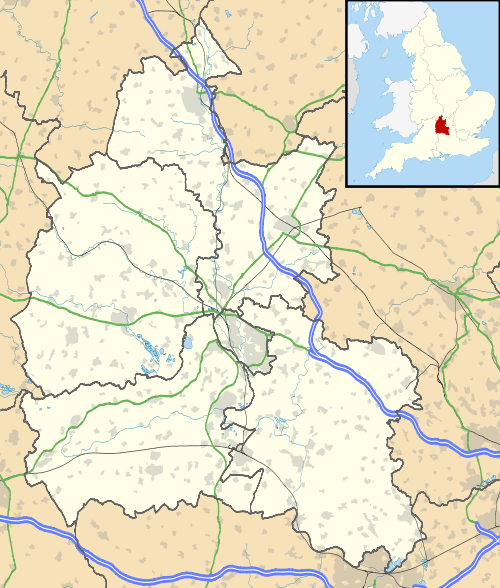 Nettlebed Location within Oxfordshire | |
| Area | 6.13 km2 (2.37 sq mi) |
| Population | 727 (2011 Census) |
| • Density | 119/km2 (310/sq mi) |
| OS grid reference | SU7086 |
| Civil parish |
|
| District | |
| Shire county | |
| Region | |
| Country | England |
| Sovereign state | United Kingdom |
| Post town | Henley-on-Thames |
| Postcode district | RG9 |
| Dialling code | 01491 |
| Police | Thames Valley |
| Fire | Oxfordshire |
| Ambulance | South Central |
| UK Parliament | |
| Website | Nettlebed Community |
Archaeology
It is claimed that in the 17th century a "Palæolithic floor" was found in Nettlebed Common.[2]
Mesolithic flint microliths and cores have been found in the parish.[3]
History
The earliest known records of the name "Nettlebed" are from the 13th century. The Inquisitiones post mortem record it as Netelbedde in AD 1252 and 1276. The name does mean a nettlebed: a place overgrown with nettles.[4]
Nettlebed village is on an ancient route through the Chiltern Hills between Henley and Wallingford, which for centuries was part of a trunk route between London and Oxford. The road between Henley and Wallingford was made into a turnpike in 1736 and ceased to be a turnpike in 1873.[5] It is now classified the A4130.
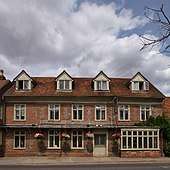
Nettlebed's strategic position led to its having several pubs, inns and coaching inns. They included the White Hart, which is 17th-century,[6] and the Bull Inn[7] and Sun Inn,[8] which are 18th-century. Only the White Hart in the High Street is still trading.[9]
Nettlebed had a sub-post office and general store in Watlington Street. It has now ceased trading and is a private house.
In 2012 Thierry Kelaart and Patrick Heathcote-Amory, son of Sir Ian Heathcote-Amory were married at St Bartholomew's parish church. Michael Middleton acted as father of the bride and guests included the Duchess of Cambridge.[10]
The house at 25, High Street, also known as the Old Priest House, is a Grade II listed building. The building is probably 16th-century with an 18th-century front and 19th-century windows.[11]
Parish church
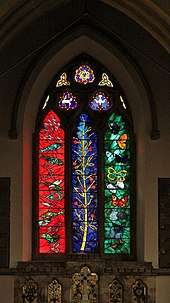
The Church of England parish of Saint Bartholomew was originally a chapelry of the adjacent parish of Benson. There is a record of the Empress Matilda giving the benefice of Benson, including chapels at Nettlebed and Warborough, to the Augustinian Abbey at nearby Dorchester, Oxfordshire in about AD 1140.[12]
The Mediæval church building was replaced in 1845–46 by the present Gothic Revival brick building, designed by a member of the Hakewill family of architects.[13] The only surviving part of the previous church is the lower stages of the brick west tower, which seems to be 18th-century.[14]
The church has some 20th-century stained glass windows, including two made in 1970 by John Piper and Patrick Reyntiens. One is the chancel east window, in which a central tree of life is flanked by fish on one side and butterflies on the other.[15] The other is the baptistery south window in the south aisle. This shows a tree of life with birds perching in it including an owl, a hawk and a pheasant.[16]
The tower has a ring of six bells, all cast by Charles and George Mears of the Whitechapel Bell Foundry in 1846.[17]
Pottery
Bricks, tiles and pottery were made in Nettlebed from the second half of the 14th century[18][19] until the 1930s. In the 15th century Nettlebed supplied ceramic tiles to Abingdon Abbey[18] and bricks to Stonor House.[20] The name "Crocker End" means "Potter's End". One remaining brick "bottle kiln" is preserved in Nuffield. It may be 17th-century. It is a Grade II* listed building.[21]
In 1674 George Ravenscroft obtained from Nettlebed the sand used in the make the first flint glass.
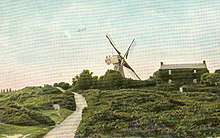
Windmill
Nettlebed had what seems to have been the only smock mill in Oxfordshire.[22] It used to be at Chinnor but was moved to a windier site at Nettlebed in about 1825. It was a slender octagonal building with four common sails and a fantail. It burned down in 1912.[23]
Amenities
Nettlebed Folk Club
The village has a long-established and highly regarded folk club which holds concerts on Monday evenings from 8pm at The Village Club in Nettlebed High Street. The Folk Song Club is a volunteer run, non-profit organisation. It was founded in July 1975 at the Bull Inn. When Brakspear Brewery closed the Bull Inn in 1991, the club moved to its present venue, which has capacity for 200 people.[24]
Many notable singers and musicians have performed at the club. They include Martin Carthy, Fairport Convention, John Kirkpatrick, Ralph McTell, Show of Hands, Steeleye Span, Richard Thompson.[24]
The Club is also known for special performances such as its "Feast of Fiddles'" where a mix of leading national performers and local artists provide themed evenings. In 2002 the club won the BBC Radio 2 Folk Club of the Year Award.[25]
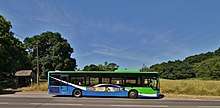
Transport
Thames Travel bus route X38 links Nuffield with Wallingford and Oxford in one direction and Henley and Reading, Berkshire in the other. It stops on the A4130 main road at Nettlebed Green, near the brick kiln at the east end of the village. Buses run generally hourly from Mondays to Saturdays. There is no Sunday service.[26]
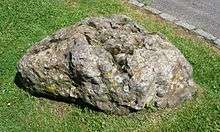
Notable residents
- Flemings
- Lucy Fleming, actress
- Peter Fleming, writer and traveller
- Celia Johnson, star of the 1945 film Brief Encounter (also Peter Fleming's wife)
- Others
- Sir Ninian Stephen, Australian judge and later 20th Governor-General of Australia, born in Nettlebed to Scottish parents in 1923 and emigrated to Australia in 1940
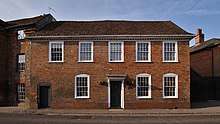
See also
- Crocker End House – former rectory
References
- "Area: Nettlebed CP (Parish): Key Figures for 2011 Census: Key Statistics". Neighbourhood Statistics. Office for National Statistics. Retrieved 1 December 2013.
- "Early history". History of Nettlebed. Nettlebed Community. Retrieved 1 September 2017.
- Case 1952–53, pp. 3–10.
- Ekwall 1960, Nettlebed
- Rosevear, Alan. "Turnpike Roads in England".
- Historic England. "The White Hart Hotel (Grade II) (1369327)". National Heritage List for England. Retrieved 23 July 2018.
- Historic England. "The Bull Inn (Grade II) (1047383)". National Heritage List for England. Retrieved 23 July 2018.
- Historic England. "The Sun Inn Public House (Grade II) (1181154)". National Heritage List for England. Retrieved 23 July 2018.
- "The White Hart". Tailor Made Dining. Retrieved 23 July 2018.
- Nikkhah, Roya (30 September 2012). "Kate and the Middletons all smiles at wedding of family friend". The Daily Telegraph.
- Page 1907, pp. 87–90.
- Sherwood & Pevsner 1974, p. 714.
- Historic England. "Church of St Bartholomew (Grade II) (1369329)". National Heritage List for England. Retrieved 23 July 2018.
- Anonymous 2012, p. 3.
- Anonymous 2012, p. 4.
- Davies, Peter (17 January 2007). "Nettlebed S Bartholomew". Dove's Guide for Church Bell Ringers. Central Council of Church Bell Ringers. Retrieved 1 December 2013.
- Mellor et al. 1994, p. 33.
- Mellor et al. 1994, p. 149.
- Mellor et al. 1994, p. 201.
- Historic England. "Brick Kiln (Grade II*) (1181146)". National Heritage List for England. Retrieved 23 July 2018.
- Foreman 1983, plates 66, 67.
- Foreman 1983, p. 127.
- "Nettlebed Folk Club". Retrieved 23 July 2018.
- "Previous winners". Radio 2 Folk Awards 2006. BBC Online. Retrieved 7 February 2011.
- "river rapids X38 X39 X40" (PDF). Thames Travel. Retrieved 23 July 2018.
- Historic England. "25, High Street (Grade II) (1047382)". National Heritage List for England. Retrieved 24 July 2018.
Bibliography
- Anonymous (2012). John Piper and the Church a Stained-Glass Tour of Selected Local Churches. Dorchester-on-Thames: Friends of Dorchester Abbey.CS1 maint: ref=harv (link)
- Case, Humphrey (1952–53). "Mesolithic finds in the Oxford area" (PDF). Oxoniensia. Oxford Architectural and Historical Society. XVII–XVIII: 1–13.CS1 maint: ref=harv (link)
- Ekwall, Eilert (1960) [1936]. Concise Oxford Dictionary of English Place-Names (4th ed.). Oxford: Oxford University Press. Nuffield. ISBN 0198691033.CS1 maint: ref=harv (link)
- Foreman, Wilfrid (1983). Oxfordshire Mills. Chichester: Phillimore & Co Ltd. p. 127. ISBN 0-85033-441-1.CS1 maint: ref=harv (link)
- Mellor, Maureen; Cowell, Mike; Newns, Sarah; Vince, Alan (1994). "A Synthesis of Middle and Late Saxon, Medieval and Early Post-medieval Pottery in the Oxford Region" (PDF). Oxoniensia. Oxfordshire Architectural and Historical Society. LIX.CS1 maint: ref=harv (link)
- Page, William, ed. (1907). "The abbey of Dorchester". A History of the County of Oxford. Victoria County History. 2: Ecclesiastical History, etc. Westminster: Archibald Constable & Co. pp. 87–90.CS1 maint: ref=harv (link)
- Sherwood, Jennifer; Pevsner, Nikolaus (1974). Oxfordshire. The Buildings of England. Harmondsworth: Penguin Books. pp. 714–715. ISBN 0-14-071045-0.CS1 maint: ref=harv (link)
